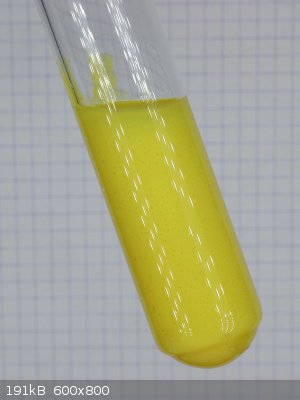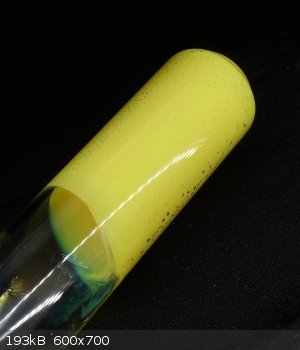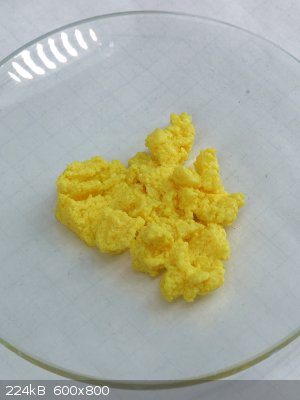woelen
Super Administrator
        
Posts: 7977
Registered: 20-8-2005
Location: Netherlands
Member Is Offline
Mood: interested
|
|
Amazing fluorescent precipitate of copper(I) with propargyl alcohol
I just did an experiment with propargyl alcohol, which has structure HC≡CCH2OH.
It has a triple bond. I expected it to have certain properties, similar to acetylene.
One of the well-known reactions of acetylene is the formation of copper(I) acetylide and silver(I) acetylide. These can be made by leading the gas
through a solution of a soluble copper(I) complex or a solution of a soluble silver(I) salt.
Copper(I) can be brought in solution in a mildly reducing environment, in which also is some coordinating agent, which keeps the copper(I) in
solution. Such a solution can be made by dissolving copper sulfate in dilute ammonia and then adding a mild reductor like Na2SO3 or NH2OH.
With the propargyl alcohol I did the following:
Put three big drops of the alcohol in a test tube.
Add 4 ml of distilled water and shake, until all of the alcohol is dissolved.
In a separate test tube, dissolve a small spatula of copper sulfate 5-hydrate in a little water. The alcohol certainly was in (large) excess, relative
to the copper(II).
Add this solution to the solution of the propargyl alcohol.
---> This does not lead to any reaction. The liquid remains pale blue.
In a separate test tube dissolve a spatula full of hydroxylamine sulfate in water and add a tiny amount of NaOH to release some free NH2OH. The
hydroxylamine sulfate was in excess, so the solution still contains quite some NH3OH(+) ions and some free NH2OH.
Add this solution to the solution of copper(II) and propargyl alcohol. When this is done, then the liquid becomes dark green and quickly becomes
turbid. The dark green color is a beautiful deep green color, not some muddy brown/green.
Within half a minute, the color of the liquid changes from dark deep green to lime green and finally a flocculent yellow/green precipitate is formed.
The color is due to fluorescence in the daylight LED lighting. I also took out my UV-light and this gives a beautiful cyan fluorescence with the
precipitate. This is one of the most remarkably colored precipitates I have ever made.
I added more NH2OH to the liquid. This does not lead to further changes.
On acidification with dilute H2SO4 the precipitate quickly dissolves and a colorless liquid is obtained. This also is remarkable. I now managed to get
copper(I) in solution in a strongly acidic solution. This solution is perfectly colorless, like water and totally clear.
Finally, I added some 10% H2O2 to the liquid. This makes the liquid pale blue, the color of copper(II) ions in water.
I did not yet have a thorough look at the internet about this reaction. Searching on the combination of copper, propargyl alcohol or copper(I) and
propargyl alcohol does not give any links about this fluorescent compound.
Tomorrow I will try with other mild reductors (e.g. Na2SO3 or NaH2PO2) to see whether the florescent precipitate really is due to the combination of
copper(I) and propargyl alcohol, or that the hydroxylamine also is part of the precipitate/complex.
I'll also make pictures of this, these will follow later on. If one has access to propargyl alcohol, then one should definitely try this reaction. It
really is amazing.
-------------------------------------------------------------------------
I also did an experiment with silver(I). A solution of silver nitrate and propargyl alcohol does not give any precipitate. This is quite different
from the behavior with acetylene gas. That gives a precipitate, even in acidic solution.
On addition of a very dilute solution of NaOH, an off-white precipitate is formed, which over several minutes turns pink and then turns pale
red/brown, with little dark red platelets in the otherwise finely powdered precipitate. The reaction with silver(I) also is peculiar, but not nearly
as spectacular looking as the reaction with copper(I).
Without the propargyl alcohol, a solution of silver nitrate gives a dark brown precipitate of Ag2O with NaOH, so there definitely is something
interesting going on.
|
|
|
dawt
Hazard to Self
 
Posts: 74
Registered: 9-5-2016
Location: EU
Member Is Offline
Mood: fluorescent
|
|
Outstanding! I had noticed something similar during my thesis when I attempted a Cu(I) catalyzed click reaction and forgot to add the azide. Totally
forgot about it and didn't pursue it further, so thanks for reminding me  I
*think* my alkyne was tert-butyl 3-oxopent-4-ynoate, but I'll have to dig through my notes later for the exact conditions. I
*think* my alkyne was tert-butyl 3-oxopent-4-ynoate, but I'll have to dig through my notes later for the exact conditions.
|
|
|
Bedlasky
International Hazard
    
Posts: 1219
Registered: 15-4-2019
Location: Period 5, group 6
Member Is Offline
Mood: Volatile
|
|
Interesting as usually, Woelen. I never heard about propargyl alcohol.
|
|
|
woelen
Super Administrator
        
Posts: 7977
Registered: 20-8-2005
Location: Netherlands
Member Is Offline
Mood: interested
|
|
I purchased some propargyl alcohol, because of its triple bond. It is the simplest compound, available for hobbyists, having a triple bond, which is
easier to handle than ethyn (which can be made in impure form from technical grade calcium carbide). It also is miscible with water, allowing many
experiments to be done with metal salts and all kinds of oxidizers. I hope to find some time next weekend to investigate this interesting reaction in
more detail, using other reductors and maybe even isolating and drying some of the yellow compound (first in very small quantities, I do not know
whether it is explosive or not, I know that copper acetylide is explosive).
|
|
|
Metacelsus
International Hazard
    
Posts: 2531
Registered: 26-12-2012
Location: Boston, MA
Member Is Offline
Mood: Double, double, toil and trouble
|
|
I did copper(I) catalyzed couplings of propargyl alcohol with other terminal alkynes quite a few times during my undergrad research. I would start
with CuCl and dissolve it in a butylamine/water mixture, then add hydroxylamine to remove traces of copper(II).
If there is any copper(II) present, this will cause oxidative dimerization of the propargyl alcohol to hexa-2,4-diyne-1,6-diol. I don't think this is
fluorescent, but it might go on to form fluorescent oligomers.
|
|
|
woelen
Super Administrator
        
Posts: 7977
Registered: 20-8-2005
Location: Netherlands
Member Is Offline
Mood: interested
|
|
I tried a similar experiment with a different reductor.
I dissolved some propargyl alcohol in water (3 drops in 2 ml of water).
In a separate test tube I dissolved copper sulfate in ammonia, giving a deep blue solution. To this, I added an excess amount of sodium dithionite, to
get a colorless solution, which also remains colorless when in contact with air (that's why I added an excess of sodium dithionite).
I added the colorless ammoniacal copper(I) solution to the propargyl alcohol. At once, the bright yellow fluorescent precipitate is formed. So, this
precipitate really is something with copper(I) and propargyl alcohol at high pH. The reductor, used to make the copper(I) is not important.
I made an interesting observation: I have a small UV laser LED (which consumes a few mA at 5 V). When the dot of the laser shines on the yellow
precipitate, then a cyan fluorescence can be observed. With the dithionite, however, the fluorescence slowly fades and the spot on which the UV-light
shines becomes brown. In just a matter of a few tens of seconds, a nice brown spot is produced at the place where the UV-light shines. With the
hydroxyl amine no brown spot is formed. I am amazed by the speed of the change of color in the UV-light. The LED is not intense at all, it just takes
a few mA, so the light output is just 10 mW or so.
|
|
|
woelen
Super Administrator
        
Posts: 7977
Registered: 20-8-2005
Location: Netherlands
Member Is Offline
Mood: interested
|
|
I isolated the yellow compound and dried it. The yellow compound absorbs an amazing amount of water and after drying only a very little amount
remained. The color also shifted. It lost its beautiful bright yellow color and becomes yellow/brown. The dried solid is somewhat energetic. It can be
ignited easily and then keeps burning with a sparkling/sputtering flame. Large amounts of carbon remain behind, but the burning does not produce any
soot. The material is not nearly as energetic as the acetylide, but seeing it burn is quite interesting though.
I made pictures and videos. More will follow soon over here.
|
|
|
woelen
Super Administrator
        
Posts: 7977
Registered: 20-8-2005
Location: Netherlands
Member Is Offline
Mood: interested
|
|
I now have a few pictures and videos I want to share:
A picture of the precipitate:

Here you see that the precipitate completely solidifies.

And here you see the solidified material, well-rinsed with distilled water and filtered.

In this video you can see formation of the precipitate.
Attachment: cu_propargyl_2.mp4 (2.6MB)
This file has been downloaded 224 times
|
|
|
wg48temp9
National Hazard
   
Posts: 761
Registered: 30-12-2018
Location: not so United Kingdom
Member Is Offline
|
|
Do you or anyone else know what the reaction conditions are for the synthesis of propargyl alcohol from formaldehyde and acetylene or the reaction
of ethylene glycol with acetylene.
I want to try your very interesting experiment.
PS: I have now found the following paper that will be useful:
Attachment: C2H2-chiddix1967.pdf (604kB)
This file has been downloaded 236 times
[Edited on 7/21/2020 by wg48temp9]
I am wg48 but not on my usual pc hence the temp handle.
Thank goodness for Fleming and the fungi.
Old codger' lives matters, wear a mask and help save them.
Be aware of demagoguery, keep your frontal lobes fully engaged.
I don't know who invented mRNA vaccines but they should get a fancy medal and I hope they made a shed load of money from it.
|
|
|